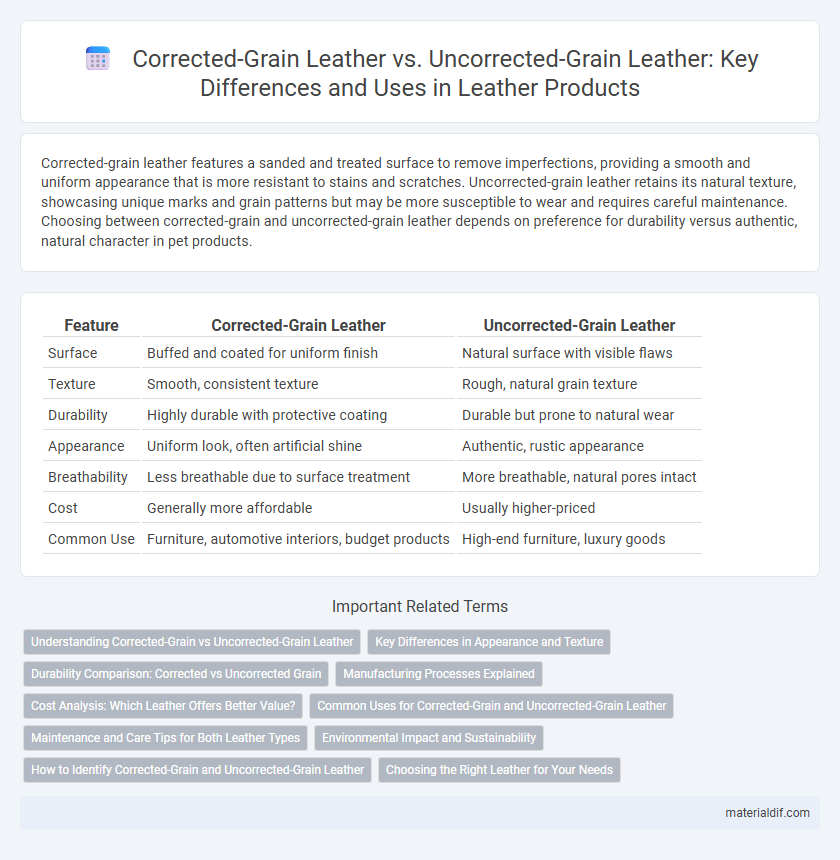Corrected-grain leather features a sanded and treated surface to remove imperfections, providing a smooth and uniform appearance that is more resistant to stains and scratches. Uncorrected-grain leather retains its natural texture, showcasing unique marks and grain patterns but may be more susceptible to wear and requires careful maintenance. Choosing between corrected-grain and uncorrected-grain leather depends on preference for durability versus authentic, natural character in pet products.
Table of Comparison
| Feature | Corrected-Grain Leather | Uncorrected-Grain Leather |
|---|---|---|
| Surface | Buffed and coated for uniform finish | Natural surface with visible flaws |
| Texture | Smooth, consistent texture | Rough, natural grain texture |
| Durability | Highly durable with protective coating | Durable but prone to natural wear |
| Appearance | Uniform look, often artificial shine | Authentic, rustic appearance |
| Breathability | Less breathable due to surface treatment | More breathable, natural pores intact |
| Cost | Generally more affordable | Usually higher-priced |
| Common Use | Furniture, automotive interiors, budget products | High-end furniture, luxury goods |
Understanding Corrected-Grain vs Uncorrected-Grain Leather
Corrected-grain leather undergoes surface sanding and an added pigment layer to mask imperfections, resulting in a uniform appearance ideal for high-quality furniture and automotive upholstery. Uncorrected-grain leather retains its natural texture and markings, showcasing the hide's authenticity and breathability, commonly preferred for luxury goods and artisanal products. Understanding the balance between durability and natural aesthetics helps consumers choose the right leather type for their specific needs.
Key Differences in Appearance and Texture
Corrected-grain leather features a smooth, even surface achieved through sanding and embossing, often coated with pigments to mask imperfections, resulting in a consistent appearance but less natural texture. Uncorrected-grain leather retains its original surface with visible natural markings, scars, and pores, providing a unique, authentic look and a more tactile, supple feel. The key difference lies in corrected-grain's uniform finish versus uncorrected-grain's rugged, natural character.
Durability Comparison: Corrected vs Uncorrected Grain
Corrected-grain leather undergoes surface sanding and coating, enhancing its resistance to scratches and stains, which contributes to higher durability in high-use environments. Uncorrected-grain leather retains the natural texture and imperfections, offering a more breathable material but with reduced protection against wear and tear over time. The durability comparison favors corrected-grain leather for longevity and maintenance ease, while uncorrected-grain leather excels in aesthetic uniqueness and natural aging.
Manufacturing Processes Explained
Corrected-grain leather undergoes a refining process where the natural grain surface is sanded or buffed to remove imperfections, then embossed with a synthetic grain pattern and coated with pigments or finishes for a uniform appearance. Uncorrected-grain leather retains its natural surface, preserving the original texture, marks, and blemishes from the animal hide, providing a more authentic and breathable material. Manufacturing corrected grain leather involves more processing steps including sanding, embossing, and finishing, while uncorrected grain leather requires minimal treatment to maintain its natural look and feel.
Cost Analysis: Which Leather Offers Better Value?
Corrected-grain leather undergoes surface sanding and artificial grain application, making it more affordable due to mass production methods but often less breathable and natural in texture. Uncorrected-grain leather maintains the original hide's imperfections, resulting in higher durability and premium aesthetics, which typically increase its price point. When evaluating cost versus longevity and appearance, uncorrected-grain leather offers better value for products requiring authentic character and extended wear.
Common Uses for Corrected-Grain and Uncorrected-Grain Leather
Corrected-grain leather is commonly used in furniture, automotive upholstery, and commercial handbags due to its uniform appearance and enhanced durability. Uncorrected-grain leather is favored for high-end products like luxury boots, premium jackets, and artisanal leather goods where natural texture and character are prized. Both types serve distinct markets based on aesthetic preference and functional requirements.
Maintenance and Care Tips for Both Leather Types
Corrected-grain leather requires less maintenance due to its protective topcoat that resists stains and scratches, though regular cleaning with a damp cloth and occasional conditioning with a leather conditioner is essential to prevent drying. Uncorrected-grain leather, also known as full-grain leather, demands more careful upkeep to preserve its natural texture, including gentle cleaning with a mild leather cleaner, avoiding excessive moisture, and frequent conditioning to maintain suppleness and prevent cracking. Both leather types benefit from keeping them away from direct sunlight and heat sources to extend their lifespan and appearance.
Environmental Impact and Sustainability
Corrected-grain leather undergoes extensive sanding, buffing, and chemical treatments that increase its environmental footprint due to higher energy use and pollutant release, while uncorrected-grain leather retains its natural surface, requiring fewer processing steps and chemicals. The sustainable appeal of uncorrected-grain leather lies in its minimal treatment, preserving more of the hide's original structure and reducing waste production during manufacturing. Choosing uncorrected-grain leather supports eco-friendlier practices by promoting resource efficiency and lowering emissions associated with leather finishing processes.
How to Identify Corrected-Grain and Uncorrected-Grain Leather
Corrected-grain leather can be identified by its smooth, uniform surface achieved through sanding and embossing, which often conceals natural imperfections. Uncorrected-grain leather retains its original surface texture with visible scars, wrinkles, and pores, showcasing the hide's natural character. Examining the leather's texture closely and noting the presence or absence of surface treatments helps distinguish between these two types.
Choosing the Right Leather for Your Needs
Corrected-grain leather undergoes surface sanding and an artificial grain application, making it ideal for products requiring uniform texture and enhanced durability, such as upholstery and footwear. Uncorrected-grain leather maintains the natural surface with visible imperfections, offering a more authentic look and developing a rich patina over time, perfect for luxury goods and artisan crafts. Selecting between corrected and uncorrected grain depends on desired aesthetics, usage wear, and long-term maintenance preferences.
Corrected-grain leather vs Uncorrected-grain leather Infographic

 materialdif.com
materialdif.com